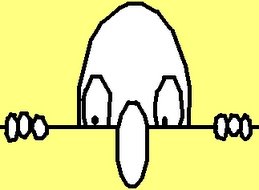In 1787, Catherine the Great, Tsarina of Russia, was touring the southern Ukraine province where her former lover Prince Grigory Aleksandrovich Potemkin was Governor. Potemkin, hoping to retain his position and such influence as he had over Catherine, reportedly made a great effort to line her route with happy Ukrainian peasants living in beautiful villages. While the real conditions which Potemkin thus concealed may not have been all that bad by the standards of the period, his efforts to ensure that the Tsarina left with only the very best impression of his governance bequeathed to us the phrase “Potemkin village” referring to any effort to conceal a less than happy reality by means of some façade, false front, or elaborate charade.
The Soviets frequently demonstrated a fine grasp of the concept during their 75-year rule. In one famous example, they introduced their first jet engine heavy bomber to the world at the 1954 May Day Parade in Moscow when a single example flew over the parade. The following year, several more of these Mi-4 Bison bombers flew above the parade. The appearance of these additional aircraft in 1955 confounded U.S. analysts who had predicted a slower production rate. Alarm soon developed over a possible “bomber gap” between the USSR and the U.S. This alarm increased on August 12, 1955, when a group of 10 and then a second group of 18 Mi-4 Bison bombers appeared in the annual Soviet Air Force Day aerial parade. These 28 aircraft were twice as many as had flown in May and four times the number of new B-52 bombers then in U.S. service. It was only some years later that the U.S. learned that the Soviets had sent every Mi-4 they could find into the air and then had some of the aircraft fly out of sight so that they could fly back to make a second appearance, giving observers the chance to count more of the bombers than actually existed at that time.
The Russian Federation has shown that this talent survives in the 21st Century. For all of the recent attention to the wealth and economic stability brought to Russia by increased oil prices and the re-emergence around the world of Russian aircraft, submarines, naval vessels, and the deployment of new missiles, there is a certain “Potemkin village” quality to it. Behind the bravado, parades, and military displays the Russian Federation remains a wounded giant, especially when compared to the Soviet Union. Today’s Russian army by some reports should consist of 10 divisions, 7 brigades, and 13 regiments. However, military analysts in Russia make it clear that the combat ready force is significantly smaller than this. The Army remains troubled by its broken system of conscription and its accompanying evils such as often lethal hazing of new draftees. The Air Force and Navy face equal or even greater challenges with an aging inventory of equipment and slow to non-existent procurement of the latest generation weapons’ systems to replace what are often worn-out Soviet era models.
Many of Putin’s supporters demonstrate a certain nostalgia for the Soviet Union, especially the Soviet Union that with its rival the United States dominated the world. The ideological contest that made rivals of these two superpowers disappeared with the collapse of the Soviet Union as did many of the economic and military resources that made the USSR's superpower status plausible. Russia is using today's energy windfall to buy back some of those lost superpower trappings in the form of new missiles, tanks, etc. for its armed forces while ignoring the . So far, Medvedev's solution has been to announce a series of reform plans, as did Yeltsin and Putin, but the resistance to real reform is strong and none of these three has yet broken it.
Meanwhile, Moscow has concluded that there is little cost in also seeking to revive its lost superpower status by criticizing and challenging U.S. policies and actions around the world. The issues at the center of these confrontations are not as important to Moscow as the resulting impression around the world of Russian and the United States butting heads and locked in struggle. The impression becomes fact for many people and thus the Russian Federation is once again a “superpower” linked with and locked in competition with the United States, concealing the reality that only the latter still has the military, economic, and industrial resources and global reach of a superpower. In these confrontations Moscow is settling for the appearance rather than making the hard decisions on economic, foreign, and military policies that might in fact give substance to its claims to a revival of Russian power.
Tuesday, July 22, 2008
Subscribe to:
Post Comments (Atom)


No comments:
Post a Comment